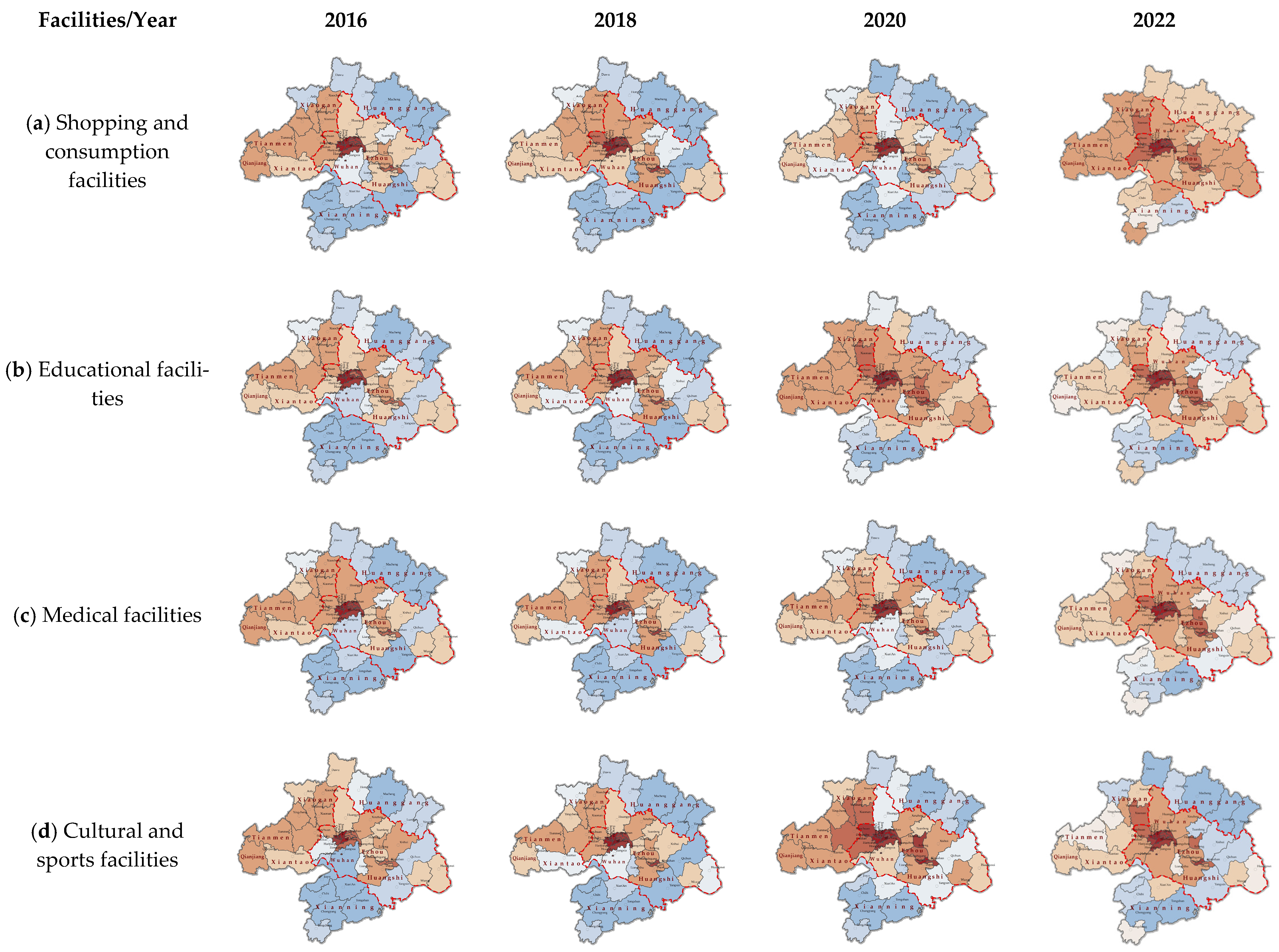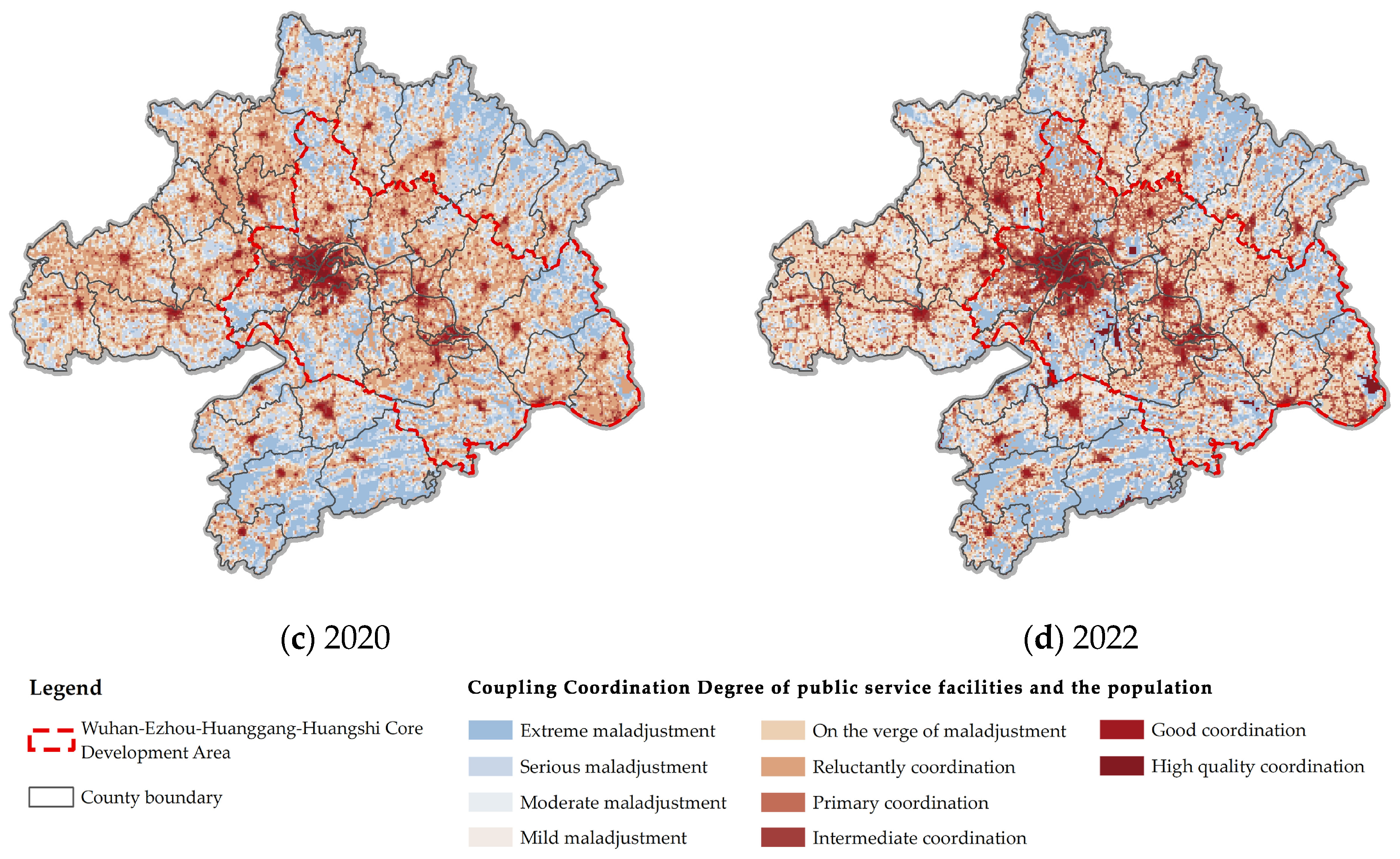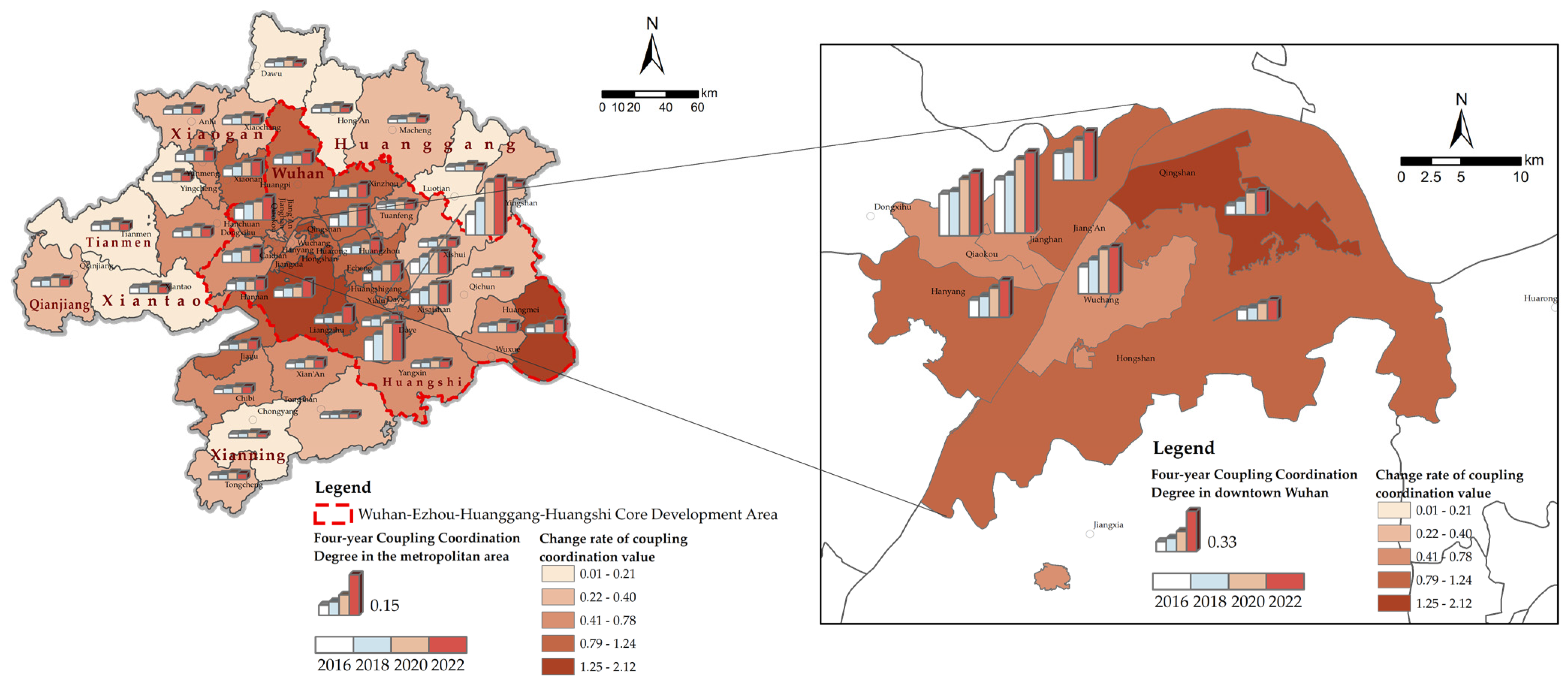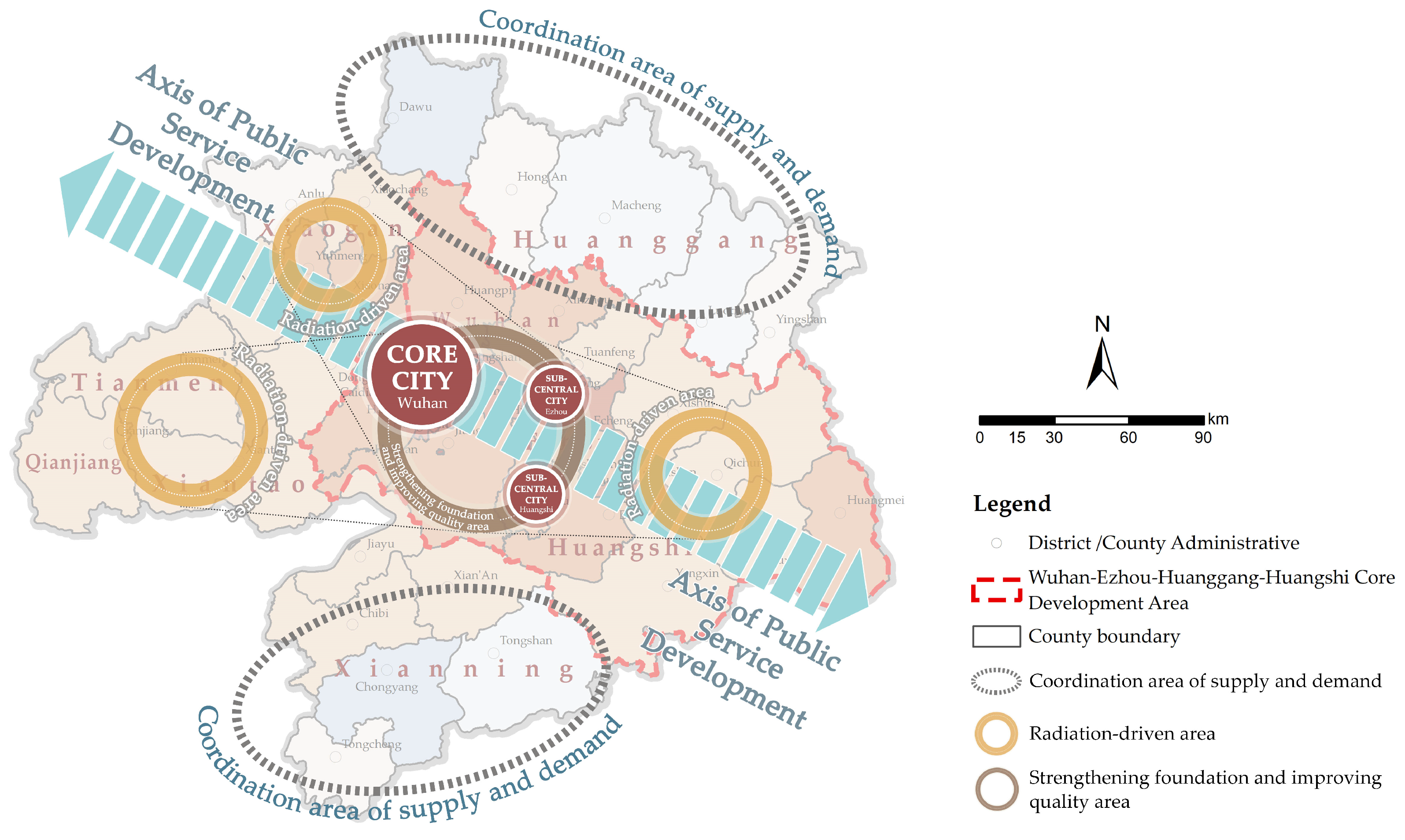Spatiotemporal Evaluation of the Coupling Relationship between Public Service Facilities and Population: A Case Study of Wuhan Metropolitan Area, Central China
Abstract
:1. Introduction
2. Materials and Methods
2.1. Research Area and Unit
2.2. Data Sources
2.3. Research Methods
2.3.1. Kernel Density Analysis
2.3.2. Objective Weighting Method
2.3.3. Supply Index and Demand Index
2.3.4. Coupling Coordination Model
2.3.5. Division of the Coupling Coordination Grade
3. Results
3.1. Distribution Characteristics of Public Facilities in the Wuhan Metropolitan Area
3.2. Analysis of the Coupling Coordination Relationships of Public Facilities in the Wuhan Metropolitan Area
3.2.1. Coupling Coordination Relationships at the County Level
3.2.2. Coupling Coordination Relationship at the Grid Level
4. Discussion
4.1. Evaluation of the Distribution Characteristics of Public Service Facilities
4.2. The Matching Relationship between the Public Service Facilities and the Population
4.3. Analysis of the Dynamic Changes in Coupling and Coordinated Development of Public Service Facilities and the Population
- (1)
- Antagonistic stage
- (2)
- Running-in stage
- (3)
- Coupling complementary stage
4.4. Promotion Strategies for Space Configuration of Public Service Facilities
- The layout and scale design of different facilities should take into account future population growth trends and changes and avoid the long-term resource bottleneck caused by short-term behavior. The construction of elderly care facilities should be focused on the resources that can continuously support the growth of the elderly population and meet the service demand in the future. Focus on the coverage of old-age care centers and nursing homes at the life circle level and rely on public participation to strengthen the co-construction of basic old-age facilities in communities. For shopping and consumption facilities and living service facilities that are relatively perfect, the quality should be improved to avoid repeated construction.
- Ensure the balanced distribution of public service facilities in the region and avoid excessive concentration of resources in some areas. Through policy guidance and market mechanism, the inclination of resources will be promoted to underdeveloped areas and improve the accessibility and social fairness of public services. With Wuhan as the center, the foundation of existing public service facilities in the Wu-E-Huang-Huang core development area should be stabilized, and the northern and southern wings of the WMA should be connected to narrow the differences in public service allocation among districts and counties.
- Regional collaboration should be strengthened, and a high-quality public service facility structure system should be steadily built in the WMA. According to the results of the evaluation of public service facilities in all districts and counties, the metropolitan area was divided into three development areas: strengthening foundation and improving quality area, radiation-driven area, and coordination area of supply and demand (as shown in Figure 10).
5. Conclusions
Author Contributions
Funding
Institutional Review Board Statement
Informed Consent Statement
Data Availability Statement
Conflicts of Interest
References
- National New Urbanization Plan (2014–2020). Available online: https://www.gov.cn/gongbao/content/2014/content_2644805.htm (accessed on 1 December 2023).
- Wuhan Metropolitan Area Development Plan. Available online: https://www.wuhan.gov.cn/sy/whyw/202212/t20221208_2111996.shtml (accessed on 10 December 2023).
- Yunitsyna, A.; Shtepani, E. Investigating the socio-spatial relations of the built environment using the Space Syntax analysis—A case study of Tirana City. Cities 2023, 133, 104147. [Google Scholar] [CrossRef]
- Michalos, A.C.; Zumbo, B.D. Public Services and the Quality of Life. Soc. Indic. Res. 1999, 48, 125–157. [Google Scholar] [CrossRef]
- Contreras, D.; Bhamidipati, S.; Wilkinson, S. Social vulnerability and spatial inequality in access to healthcare facilities: The case of the Santiago Metropolitan Region (RMS), Chile. Socio-Econ. Plan. Sci. 2023, 90, 101735. [Google Scholar] [CrossRef]
- TangBo; HuangZhangdi Research on the spatial characteristics of urban integration from multi-dimensions: A case study in the Guangzhou-Qingyuan metropolitan area. Front. Earth Sci. 2023, 10, 1022982.
- Zhang, B.; Zhou, E. The Evaluation of Spatial Distribution Equity of Public Service Facilities in Coastal Cities. J. Coast. Res. 2020, 103, 1060–1064. [Google Scholar] [CrossRef]
- Hui, Y. Research on infrastructure integration of 13 cities in Beijing, Tianjin and Hebei based on Coupling Coordination Degree model. Econ. Manag. 2020, 34, 15–24. [Google Scholar]
- Yang, Y.; Gao, D.; Li, R.; Du, H. The Impact of Basic Public Health Services on Migrant Peasant Workers’ Urban Integration: Evidence from China. Sustainability 2023, 15, 2420. [Google Scholar] [CrossRef]
- Teitz, M. Toward a Theory of Urban Public Facility Location. In Papers in Regional Science; John Wiley & Sons, Ltd.: Hoboken, NJ, USA, 1968; Volume 21, pp. 35–51. [Google Scholar]
- Cao, L.; Wang, J.; Wang, H.; Cui, H. Evolutional Analysis of Coupling between Infrastructure and Population Agglomeration in Beijing-Tianjin-Hebei Region: An Analysis Based on Push-pull Theory. Sci. Geogr. Sin. 2019, 39, 1256–1264. [Google Scholar]
- Yu, Q. Research on the coupling coordination between the carrying capacity of public cultural services and high-quality economic development: Taking Zhengzhou metropolitan area as an example. Resour. Dev. Mark. 2023, 39, 875–883. [Google Scholar]
- Zhang, Y.; Zou, Q.; Yang, C.; Shui, Y.; Cha, J. The Dynamic Evolution and Geographical Differences of Equalization of Basic Public Services in Nanjing Metropolitan Area. Sci. Technol. Ind. 2023, 23, 65–73. [Google Scholar]
- Zeng, P.; Zong, C. Research on the relationship between population distribution pattern and urban industrial facility agglomeration in China. Sci. Rep. 2023, 13, 16225. [Google Scholar] [CrossRef] [PubMed]
- Shi, Y.; Yang, J.; Shen, P. Revealing the Correlation between Population Density and the Spatial Distribution of Urban Public Service Facilities with Mobile Phone Data. ISPRS Int. J. Geo-Inf. 2020, 9, 38. [Google Scholar] [CrossRef]
- Lin, D.; Wang, J.; Xie, B. Research on the Matching Relationship of Transportation Land on Regional Traffic Impact Assessment. J. Transp. Eng. 2024, 24, 94–98+105. [Google Scholar]
- Huang, C.; Feng, Y.; Wei, Y.; Sun, D.; Li, X.; Zhong, F. Assessing Regional Public Service Facility Accessibility Using Multisource Geospatial Data: A Case Study of Underdeveloped Areas in China. Remote Sens. 2024, 16, 409. [Google Scholar] [CrossRef]
- Wang, W.; Zhou, Z.; Chen, J.; Cheng, W.; Chen, J. Analysis of Location Selection of Public Service Facilities Based on Urban Land Accessibility. Int. J. Environ. Res. Public Health 2021, 18, 516. [Google Scholar] [CrossRef]
- Zheng, X.; Zhao, D. Evaluating the accessibility of public service facilities to tourists and residents in island destinations: Evidence from the Changhai County. Front. Public Health 2023, 10, 1090341. [Google Scholar] [CrossRef]
- Wu, J.; Fu, J.; Wang, H.; Zhao, Y.; Yi, T. Identifying Spatial Matching between the Supply and Demand of Medical Resource. Int. J. Environ. Res. Public Health 2022, 19, 2354. [Google Scholar] [CrossRef] [PubMed]
- Lan, F.; Zhang, W.; Wen, H.; Da, H. Stratification, Spatial Agglomeration, and Unequal Public Services: Case Study in Xi’an, China. J. Urban Plan. Dev. 2020, 146, 05020004. [Google Scholar] [CrossRef]
- Sun, A.; Huang, Y.; Yang, L.; Huang, C.; Xiang, H. Assessment of the Impact of Basic Public Service Facility Configuration on Social–Spatial Differentiation: Taking the Zhaomushan District of Chongqing, China. Sustainability 2023, 16, 196. [Google Scholar] [CrossRef]
- Wang, K.; Yuan, Y.; Chen, M.; Wang, D. A POIs based method for determining spatial distribution of urban fire risk. Process Saf. Environ. 2021, 154, 447–457. [Google Scholar] [CrossRef]
- Zhou, L.; Shi, Y.; Zheng, J. Business Circle Identification and Spatiotemporal Characteristics in the Main Urban Area of Yiwu City Based on POI and Night-Time Light Data. Remote Sens. 2021, 13, 5153. [Google Scholar] [CrossRef]
- Chen Hao, Z.J. Rising Dual System of Functional Territory and Administrative Territory: Unraveling the Spatiality of Urban State and its Transformation Based on the Case Study of the City Proper of Nanjing. Econ. Geogr. 2017, 37, 59–67. [Google Scholar]
- Liu, S.; Guo, H.; Su, L. Evaluation of Quality of Life in Urban Life Circles from a Composite Perspective of Subjective Needs and the Supply of Public Amenities: A Case Study of Changbai Island, Shenyang. Sustainability 2023, 15, 10095. [Google Scholar] [CrossRef]
- Li, C.; Xia, W.; Chai, Y. Delineation of an Urban Community Life Circle Based on a Machine-Learning Estimation of Spatiotemporal Behavioral Demand. Chin. Geogr. Sci. 2021, 31, 27–40. [Google Scholar] [CrossRef]
- Zhen, W. Research on Evaluation Method of Supply and Demand Matching Degree of Public Service Facilities in Central City—Taking Tianhe District of Guangzhou as an Example. Master’s Thesis, South China University of Technology, Guangzhou, China, 2021. [Google Scholar]
- Han, J.; Yu, M. A multi-factor integration identification method of ecological security pattern and optimization suggestions: A case of Changshan county, Quzhou city. Geogr. Res. 2021, 40, 1078–1095. [Google Scholar]
- Wang, D.; Fang, Y.; Hu, Y.; Wang, J. Territorial Spatial Planning of Coastal Ecological Areas Under Land-Sea Coordination: The Case of Dapeng New District, Shenzhen. Urban Plan. Forum 2022, 232–239. [Google Scholar]
- Liu, Y.; Wu, K.; Hu, Y.; Liu, Y. Refined Governance of Public Service Facilities Based on Needs of Typical populations: A Case Study of Quarter-hour Community Service Circle in Beijing’s Huitian Area. Shanghai Urban Plan. Rev. 2023, 6, 98–104. [Google Scholar]
- Nie, J.; Huang, Y.; Shan, Z. Study on the characteristics and formation mechanism of urban system in Wuhan metropolitan area—Based on the perspective of urban network. Mod. Urban Res. 2018, 3, 110–116. [Google Scholar]
- Notice on Issuing the Outline of Planning and Construction of Wuhan-Ezhou-Huanggang-Huangshi Core Development Area. Available online: http://fgw.hubei.gov.cn/fbjd/zc/gfwj/gf/202301/t20230104_4475381.shtml (accessed on 10 December 2023).
- Xie, H.; Wang, X.; Wang, Z.; Shi, Z.; Hu, X.; Lin, H.; Xie, X.; Liu, X. Mismatch between infrastructure supply and demand within a 15-minute living circle evaluation in Fuzhou, China. Heliyon 2023, 9, e20130. [Google Scholar] [CrossRef]
- Huang, Y.; Zhou, M. Study on the Spatial Evolution Characteristics, Mechanism and Guiding Strategies of Manufacturing Industry in Wuhan Metropolitan Area. Urban Plan. Forum 2016, 6, 54–64. [Google Scholar]
- Morris, Z.; Weissburg, M.; Bras, B. Ecological network analysis of urban-industrial ecosystems. J. Ind. Ecol. 2021, 25, 193–204. [Google Scholar] [CrossRef]
- Zou, L.; Qiu, C.; Li, H.; Shi, Y. Housing Demand and Supply in the Context of the Transition to a New Development Paradigm. J. Financ. Dev. Res. 2024, 2, 3–15. [Google Scholar]
- Sun, Z.; Yan, X.; Sun, X.; Qiao, Z. Study on the spatial distribution and supporting conditions of living facilities based on POI data—Taking five districts in Jinan as an example. Geogr. Inf. World 2017, 24, 65–70. [Google Scholar]
- Wang, S.; Kong, W.; Ren, L.; Zhi, D.; Dai, B. Misunderstanding and Revision of Domestic Coupling Coordination Degree Model. J. Nat. Resour. 2021, 36, 793–810. [Google Scholar]
- Wang, Y.; Ding, Z.; Yu, M.; Shang, Z.; Song, X.; Chang, X. Quantitative analysis of the coordinated relationship between modern service industry and urbanization based on coupling model—Taking Changshu City, Jiangsu Province as an example. Geogr. Res. 2015, 34, 97–108. [Google Scholar]
- Yang, X.; Zhang, X. Study on Coupling Coordination Degree of Supply and Demand of Medical Service Facilities in China. Chin. Health Econ. 2020, 39, 39–43. [Google Scholar]
- Diakoulaki, D.; Mavrotas, G.; Papayannakis, L. Determining objective weights in multiple criteria problems: The critic method. Comput. Oper. Res. 1995, 22, 763–770. [Google Scholar] [CrossRef]
- Wang, K.; Song, H. Comparative analysis of three objective weighting methods. J. Technol. Econ. Manag. 2003, 6, 48–49. [Google Scholar]
- Xi, W. Comparative Analysis of Three Weighting Methods. China Collect. Econ. 2016, 34, 73–74. [Google Scholar]
- Krishnan, A.; Kasim, M.; Hamid, R.; Ghazali, M. A Modified CRITIC Method to Estimate the Objective Weights of Decision Criteria. Symmetry 2021, 13, 973. [Google Scholar] [CrossRef]
- Shi, Y.; Wang, J.; Zhang, Z. Spatial distribution of air pollution in Xiamen and its spatial correlation with influencing factors. Chin. J. Environ. Eng. 2014, 8, 5406–5412. [Google Scholar]
- Zhan, D.; Zhang, W.; Zhang, J.; Li, J.; Shen, L.; Dang, Y. Analysis on Spatial Agglomeration Characteristics of Beijing Public Service Facilities. Econ. Geogr. 2018, 38, 76–82. [Google Scholar]
- Zhang, X.; Yan, X.; Li, J.; Sun, Y.; Guo, P. Spatial differences in the allocation of public service facilities in downtown Tianjin from the perspective of life circle. J. Arid. Land. Resour. Environ. 2021, 35, 43–51. [Google Scholar]
- Shao, H.; Lv, S.; Cao, C. The Fairness and Influencing Factors of the Spatial Distribution of Public Services in Beijing-Tianjin-Hebei. Sustainability 2023, 15, 9217. [Google Scholar] [CrossRef]
- China Census Yearbook-2020. Available online: http://www.stats.gov.cn/sj/pcsj/rkpc/7rp/indexce.htm (accessed on 30 July 2023).
- Li, Y.; Li, Y.; Zhou, Y.; Shi, Y.; Zhu, X. Investigation of a coupling model of coordination between urbanization and the environment. J. Environ. Manag. 2012, 98, 127–133. [Google Scholar] [CrossRef]
- Wang, M.; Chen, F.; Zhang, D.; Rao, Q.; Li, J.; Tan, S. Supply-Demand Evaluation of Green Stormwater Infrastructure (GSI) Based on the Model of Coupling Coordination. Int. J. Environ. Res. Public Health 2022, 19, 14742. [Google Scholar] [CrossRef]
- Xu, S.; He, W.; Shen, J.; Degefu, D.; Yuan, L.; Kong, Y. Coupling and Coordination Degrees of the Core Water-Energy-Food Nexus in China. Int. J. Environ. Res. Public Health 2019, 16, 1648. [Google Scholar] [CrossRef]
- Song, Q.; Zhou, N.; Liu, T.; Siehr, S.; Qi, Y. Investigation of a “coupling model” of coordination between low-carbon development and urbanization in China. Energy Policy 2018, 121, 346–354. [Google Scholar] [CrossRef]














| Type | Source | Time | Explanation |
|---|---|---|---|
| Administrative boundaries at all levels | National Geographic Information Resources Directory Service System of China (https://www.webmap.cn/main.do?method=index (accessed on 1 June 2023)) | 2023 | The municipal and county administrative boundaries of cities in the WMA. Among them, “districts and counties” are two names of county-level administrative regions in China. |
| Waters data | 2023 | Area data of large rivers and lakes | |
| Elevation data | Geospatial data cloud website (https://www.gscloud.cn/search (accessed on 1 June 2023)) | 2023 | GDEMV3 30M resolution digital elevation data |
| POI data | Gaode open platform (https://lbs.amap.com/ (accessed on 30 July 2023)) | 2016–2018, 2018–2020, 2020–2022 | POI data of public service facilities in the WMA |
| Population grid data | WorldPop website (https://hub.worldpop.org/ (accessed on 30 July 2023)) | 2016–2018, 2018–2020, 2020–2022 | Population grid data with 500 × 500 m accuracy |
| Aging population data | National Bureau of Statistics of China (https://www.stats.gov.cn/sj/pcsj/rkpc/7rp/indexce.htm (accessed on 30 July 2023)) | 2016–2018, 2018–2020, 2020–2022 | Data of aging population based on the seventh population census of China |
| Facilities Category | Facility Subcategory |
|---|---|
| Shopping and consumption facilities | Convenience stores, supermarkets, shopping malls, shopping centers, characteristic commercial streets and specialty stores |
| Educational facilities | Kindergartens, primary schools, middle schools and higher education institutions |
| Medical facilities | General hospitals, medical and health care shops and clinics |
| Cultural and sports facilities | Cultural centers, cultural palaces, libraries, art galleries, museums, sports venues and sports training venues |
| Elderly care facilities | Nursing homes, health centers, and elderly care services |
| Recreational facilities | Parks, leisure squares, playgrounds, tourist attractions |
| Transportation facilities | Bus stations, subway stations, parking lots, expressway service areas |
| Living service facilities | Public toilets, talent markets, beauty salons, laundries, courier service points |
| Coupling Coordination Type | Coupling Coordination Level | Interval of Coupling Coordination Degree D Value | Coupling Coordination Degree |
|---|---|---|---|
| Low | 1 | (0, 0.013) | Extreme maladjustment |
| 2 | (0.013, 0.019) | Serious maladjustment | |
| 3 | (0.019, 0.022) | Moderate maladjustment | |
| Medium | 4 | (0.022, 0.027) | Mild maladjustment |
| 5 | (0.027, 0.041) | On the verge of maladjustment | |
| 6 | (0.041, 0.067) | Reluctant coordination | |
| 7 | (0.067, 0.123) | Primary coordination | |
| High | 8 | (0.123, 0.240) | Intermediate coordination |
| 9 | (0.240, 0.486) | Good coordination | |
| 10 | (0.486, 1) | High quality coordination |
Disclaimer/Publisher’s Note: The statements, opinions and data contained in all publications are solely those of the individual author(s) and contributor(s) and not of MDPI and/or the editor(s). MDPI and/or the editor(s) disclaim responsibility for any injury to people or property resulting from any ideas, methods, instructions or products referred to in the content. |
© 2024 by the authors. Licensee MDPI, Basel, Switzerland. This article is an open access article distributed under the terms and conditions of the Creative Commons Attribution (CC BY) license (https://creativecommons.org/licenses/by/4.0/).
Share and Cite
Liang, K.; Zou, Y.; Li, G. Spatiotemporal Evaluation of the Coupling Relationship between Public Service Facilities and Population: A Case Study of Wuhan Metropolitan Area, Central China. Sustainability 2024, 16, 7698. https://doi.org/10.3390/su16177698
Liang K, Zou Y, Li G. Spatiotemporal Evaluation of the Coupling Relationship between Public Service Facilities and Population: A Case Study of Wuhan Metropolitan Area, Central China. Sustainability. 2024; 16(17):7698. https://doi.org/10.3390/su16177698
Chicago/Turabian StyleLiang, Kaixuan, You Zou, and Guiyuan Li. 2024. "Spatiotemporal Evaluation of the Coupling Relationship between Public Service Facilities and Population: A Case Study of Wuhan Metropolitan Area, Central China" Sustainability 16, no. 17: 7698. https://doi.org/10.3390/su16177698






